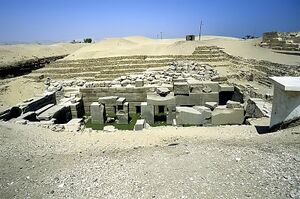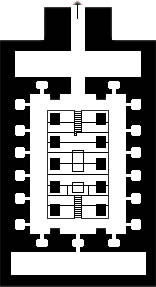أوزيريون
| Osireion | |
|---|---|
 | |
| الدين | |
| الارتباط | Ancient Egyptian |
| الموقع | |
| الموقع | Abydos |
| البلد | Egypt |
| الإحداثيات الجغرافية | 26°11′03″N 31°55′06″E / 26.1841°N 31.9184°E |
| المواد | Stone |
Osirion or Osireion is the cenotaph of Seti I, located to the rear of the Temple of Seti I at Abydos, Egypt.
It is an integral part of Seti I's temple complex and may have been built to resemble the tombs in the Valley of the Kings.[1] The site contains a stone-paved island in the centre, chambers in both wings, and a water basin around the island of yet undetermined depth, which is at least 10.4 متر (34 ft); it was probably used as a well. Access was via a 69 متر (226 ft) stone lined passage.
أبحاث حديثة
The Osireion was discovered by archaeologists Flinders Petrie and Margaret Murray, who were excavating the site in 1902–1903. The Osirion was originally built at a considerably lower level than the foundations of the temple of Seti, who ruled from ح. 1294 BCE to ح. 1279 BCE.[2] While, with regard to the depth of the building, its untypical architectural style and its mythological context, there is disagreement as to its true age, in his 1998 dissertation on Seti I, P.J. Brand (2000), mainly emphasising the numerous cartouches of Seti I found inscribed at the site, says it "can be dated confidently to Seti's reign".[3][أ]
The Egypt Exploration Society (EES) which carried out the excavations of the site had come to this same conclusion, as detailed in its excavation report published in 1933.[4]
روايات تاريخية
Strabo visited the Osireion in the first century BCE and gave a description of the site as it appeared in his time:
Above this city [Ptolemaïs] lies Abydus, where is the Memnonium, a royal building, which is a remarkable structure built of solid stone, and of the same workmanship as that which I ascribed to the Labyrinth, though not multiplex; and also a fountain which lies at a great depth, so that one descends to it down vaulted galleries made of monoliths of surprising size and workmanship.[5]
The subterranean water basin at the Osireion was consequently named "Strabo's Well" by modern excavators.
Strabo then theorises that the Osireion might have been constructed by Ismandes, or Mandes,[ب] the same purported builder as with the Labyrinth at Hawara:
But if, as they say, Memnon is called Ismandes by the Egyptians, the Labyrinth might be a Memnonium, and the work of the same person who constructed those at Abydos and at Thebes; for in those places, it is said, are some Memnonia.[5]
Strabo's uncertainty about the origins of the structure highly suggests that these were already unknown by the time of his visit. Fortunately, the EES excavations uncovered an ancient mark that probably identifies it:
- “Menmaatre [Seti I] is Benefical to Osiris”
is believed to be the ancient name given to the subterranean structure.[6] Graffiti by Egyptian priests of Dynasties XXI–XXII found in the long entrance passage, the vaulted galleries mentioned by Strabo, hint at its function:
- “The hidden / secret place of the Underworld / Duat of Menmaatre [Seti I]”
and more specifically and revealing as the:
- “Birth House of Isis”.[7]
انظر أيضاً
المراجع
- ^ Bard (1999), p. 114.
- ^ Rice (1999).
- ^ Brand (2000), p. 175.
- ^ Frankfort, de Buck & Gunn (1933a), pp. 23–25.
- ^ أ ب Strabo, 17.1.42. خطأ استشهاد: وسم
<ref>غير صالح؛ الاسم "FOOTNOTEStrabo17.1.42" معرف أكثر من مرة بمحتويات مختلفة. - ^ Frankfort, de Buck & Gunn (1933a), p. 92.
- ^ Frankfort, de Buck & Gunn (1933a), pp. 88–89.
وصلات خارجية
- The Osirion The original notes by archeologist Sir William Flinders-Petrie on the discovery of the Osirion site, published in 1903.
ببليوجرافيا
- Frankfort, H., De Buck, A. & Gunn, B. The Cenotaph of Seti I at Abydos, 2 vol. Memoir of the Egypt Exploration Society, Egypt Exploration Society. London, 1933.
- Hamilton, Keith. The Osireion: A Layman's Guide, 2018, Web, https://www.researchgate.net/publication/328225133_The_Osireion_A_Layman%27s_Guide.
- Hornung, Erik, trans. from German by David Lorton. The Ancient Egyptian Books of the Afterlife. Cornell University Press, Ithaca, New York, 1999.
- Murray, Margaret A. The Osirion at Abydos, British School of Egyptian Archeology n°1, London, 1904.
- O'Connor, David. Abydos: Egypt's First Pharaohs and the Cult of Osiris, Thames & Hudson, London, 2009 and 2011.
- Petrie, Flinders. The Osirion at Abydos
- Pinch, Geraldine. Egyptian Mythology: A Guide to the Gods, Goddesses, and Traditions of Ancient Egypt. Oxford University Press, 2002.
- Naville, Edouard. "Abydos". The Journal of Egyptian Archaeology, vol. 1, no. 1, 1914, pp. 2–8. JSTOR, www.jstor.org/stable/3853664.
- Murray, Margaret Alice., J. G. Milne, and W. E. Crum. The Osireion at Abydos. London: Histories & Mysteries of Man, 1989. Print.
خطأ استشهاد: وسوم <ref> موجودة لمجموعة اسمها "lower-alpha"، ولكن لم يتم العثور على وسم <references group="lower-alpha"/>


